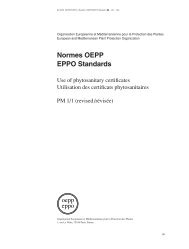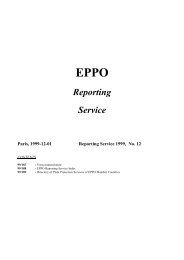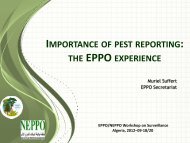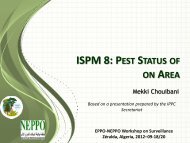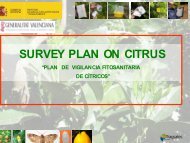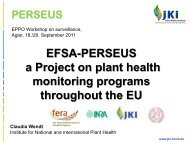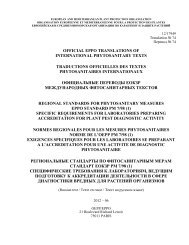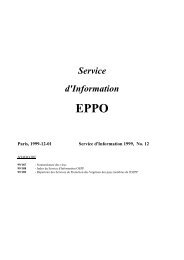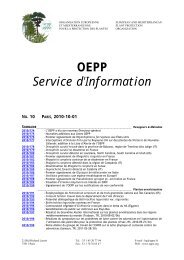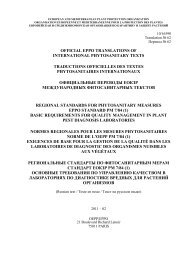EPPO Reporting Service - Lists of EPPO Standards - European and ...
EPPO Reporting Service - Lists of EPPO Standards - European and ...
EPPO Reporting Service - Lists of EPPO Standards - European and ...
You also want an ePaper? Increase the reach of your titles
YUMPU automatically turns print PDFs into web optimized ePapers that Google loves.
<strong>EPPO</strong> <strong>Reporting</strong> <strong>Service</strong> – Pests & Diseases<br />
2011/031 Eradication <strong>of</strong> Globodera rostochiensis from Western Australia (AU)<br />
In Western Australia (AU), Globodera rostochiensis (<strong>EPPO</strong> A2 List) was detected for the<br />
first time in 1986 <strong>and</strong> an eradication programme was implemented. From 1986 to 1989, G.<br />
rostochiensis was detected on 6 properties near Perth (covering approximately 15 ha). All<br />
infested sites were intensively fumigated, phytosanitary regulations were implemented to<br />
prevent any further spread, <strong>and</strong> all potato crops from Western Australia were tested (in<br />
total more than 31 000 tests were performed). Since 1989, G. rostochiensis has not been<br />
detected in Western Australia. On the 13 th <strong>of</strong> September 2010 <strong>and</strong> after a 24-year<br />
eradication programme, the NPPO <strong>of</strong> Australia <strong>of</strong>ficially declared that the pest has been<br />
eradicated from Western Australia.<br />
The pest status <strong>of</strong> Globodera rostochiensis in Western Australia is <strong>of</strong>ficially declared as:<br />
Absent.<br />
Source: INTERNET (last accessed in 2011-02)<br />
IPPC website. Pest reports (AUS-39/1) Australia. Eradication <strong>of</strong> potato cyst<br />
nematode (PCN) from Western Australia. https://www.ippc.int/<br />
Additional key words: eradication Computer codes: HETDRO, AU<br />
2011/032 Xanthomonas arboricola pv. pruni detected on Prunus laurocerasus in<br />
Toscana (IT)<br />
The NPPO <strong>of</strong> Italy recently informed the <strong>EPPO</strong> Secretariat <strong>of</strong> the detection <strong>of</strong> Xanthomonas<br />
arboricola pv. pruni (<strong>EPPO</strong> A2 List) on Prunus laurocerasus, in Toscana region. The<br />
bacterium was detected in a nursery in the province <strong>of</strong> Pistoia. All infected plants were<br />
immediately destroyed <strong>and</strong> surveys in the affected area were intensified. It can be<br />
recalled that X. arboricola pv. pruni had already been detected on this ornamental plant<br />
species in the Netherl<strong>and</strong>s (<strong>EPPO</strong> RS 2009/178).<br />
Source: NPPO <strong>of</strong> Italy (2010-11).<br />
Additional key words: detailed record, host plant Computer codes: XANTPR, IT<br />
2011/033 Details on Pseudomonas syringae pv. actinidiae in China<br />
The following details on the distribution <strong>of</strong> Pseudomonas syringae pv. actinidiae in China<br />
could be found in abstracts <strong>of</strong> Chinese publications on the Internet.<br />
Anhui province: bacterial canker <strong>of</strong> kiwifruit was first observed in 1999 in the district <strong>of</strong><br />
Yuexi, <strong>and</strong> since 1991 outbreaks have been reported (Cheng et al., 1995). It was observed<br />
that the kiwifruit bacterial canker was more severe in orchards at high elevation (above<br />
750 m altitude), <strong>and</strong> on south facing slopes (Li et al., 2001).<br />
Sichuan province: bacterial canker appeared in 1989 in the district <strong>of</strong> Cangxi <strong>and</strong> has since<br />
become the most destructive kiwifruit disease in the region (Wang et al., 1992).<br />
5




